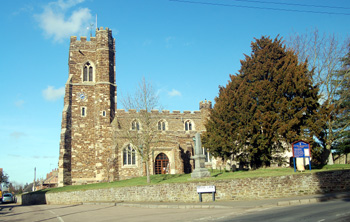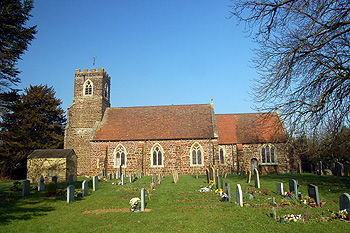Early Education in Greenfield

Flitton church from the south February 2011
Volume 81 published by Bedfordshire Historical Records Society (2002) is a series of episcopal visitations undertaken in the first twenty years of the 18th century, edited by former County Archivist Patricia Bell. At each visitation a list of questions was sent out in advance, one of which enquired about the provision of schools in each parish. Greenfield would have been recorded both under Flitton and under Pulloxhill since the north side of the High Street was in Flitton and the south side in Pulloxhill until 1984 when both sides became part of the new civil parish of Flitton and Greenfield. There was a further part of Pulloxhill, detached from the rest of the parish, around Greenfield Mill.
In 1706 the response for Flitton and Silsoe was: "There is no School, Lecture, Almeshouse [sic] or Hospital endow'd within this parish". By 1709, however there was a charity school at Flitton for nine boys or girls. This school seems to have closed by 1717 when only a school for fourteen children is recorded which was probably in Silsoe since the 1709 return recorded a school for fourteen in that village. The entry for 1720 for Flitton and Silsoe says: "We have no publick [sic] of charity School". Entries for Pulloxhill for 1706, 1717 and 1720 state that there was no schooling in the parish.
In 1818 a Select Committee was established to enquire into educational provision for the poor. This was no doubt prompted, in part, by the recent foundation of two societies promoting education and specifically the building of schools. The Society for Promoting the Lancasterian System for the Education of the Poor was established in 1808 promoting schools run along the lines pioneered by Joseph Lancaster, who had himself copied those of Dr.Andrew Bell, in which older children taught their younger fellows. The Society was renamed the British and Foreign School Society in 1814,. It was supported by a number of prominent nonconformists, Lancaster himself was a Quaker, and sought to teach a non-sectarian curriculum. In answer to this perceived nonconformist takeover of local education the National Society was formed in 1811 to encourage the teaching of poor children along Anglican lines, including the catechism. The Select Committee sent a questionnaire to all parishes in the country asking for: particulars relating to endowments for the education of children; other educational institutions; observations of parish needs etc. The return for Flitton noted a Sunday school for 42 boys and 58 girls in the village, maintained by £170 left by one of the Earls of Kent. The Pulloxhill return noted a Sunday school for 24 girls. The vicar stated: "The poor are desirous of the means of education". In those days a Sunday School was just that, a school which met on a Sunday, usually in the church or nonconformist chapel or other similar building, teaching more than the religious topics with which they are associated today.
In the country generally the number of schools built continued to grow over the next fifteen years so that by 1833 the government agreed to supplement the work of the two societies, and local benefactors, by making £20,000 per annum available in grants to help build schools. It also prompted another questionnaire to be sent to each parish in England asking for details of local educational provision. The Flitton return noted that the Sunday school now contained 35 males and 49 females and was supported by subscription. The Pulloxhill return noted that there were now two Sunday schools, one for 26 females and the other, which had begun in 1824, for 36 males. Both were supported by voluntary contributions.
The next national enquiry was in 1846/7 when the Church of England made an enquiry as to all its church schools. This was against the background of a new Whig government which championed secular education and the increasing importance of nonconformists, particularly Wesleyan Methodist, and Roman Catholics in providing schools. The return for Flitton stated: "The educational wants of this district are amply supplied" and went on to list a Sunday school, a daily school and a daily infants' school, all in Silsoe. The Pulloxhill return noted a Sunday school for 72 boys and 73 girls and a daily infants' school for 27 of each sex.
 Pulloxhill church from the south March 2011
Pulloxhill church from the south March 2011